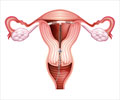Women can now kiss the unpleasant side effects of the Pill goodbye as a revolutionary contraceptive patch is being developed.
Women can now kiss the unpleasant side effects of the Pill goodbye as a revolutionary contraceptive patch is being developed.
Preliminary experiments with a gene-silencing technique called RNA interference (RNAi) have shown that it has the potential to block the production of a sperm-binding protein on the surface of egg cells in mice and humans, raising hope that this method may one day translate into an entirely new type of contraceptive.Zev Williams of Brigham and Women's Hospital in Boston, Massachusetts, US, says that the approach will help avoid the harmful side effects caused by hormonal birth control pills that may include weight gain, mood swings, and dangerous blood clots.
He stressed the need for further improvement in the contraception methods, suggesting that barrier methods such as condoms can reduce physical sensation, while intrauterine devices (IUDs)—small plastic or copper devices placed inside the woman's uterus—could in rare cases cause infertility.
"Overall there is a need for an entirely new class of contraceptives. There are really so few options for women today," the New Scientist quoted Williams as saying.
During the experiments, Williams and his collaborators explored the role of proteins found in the zona pellucida, a membrane surrounding egg cells. Sperm bind to these surface proteins as a first step towards entering and fertilising the egg.
The researchers got encouraged by the finding that mice genetically engineered to lack zona pellucida protein 3 (ZP3) were completely infertile. They further set out to see whether RNA interference could disrupt the production of ZP3 in human cells, and focused on a line of cells originally derived from embryonic human kidney in the early Seventies.
Advertisement
Williams is now planning to test whether RNAi can block pregnancy when given intravenously to normal mice. He believes that the new approach will only affect the production of ZP3 in the small number of eggs within the ovary that actively mature each month, and not the entire reserve of eggs.
Advertisement
LIN/V









